North America Pharmaceutical Contract Manufacturing Market Size
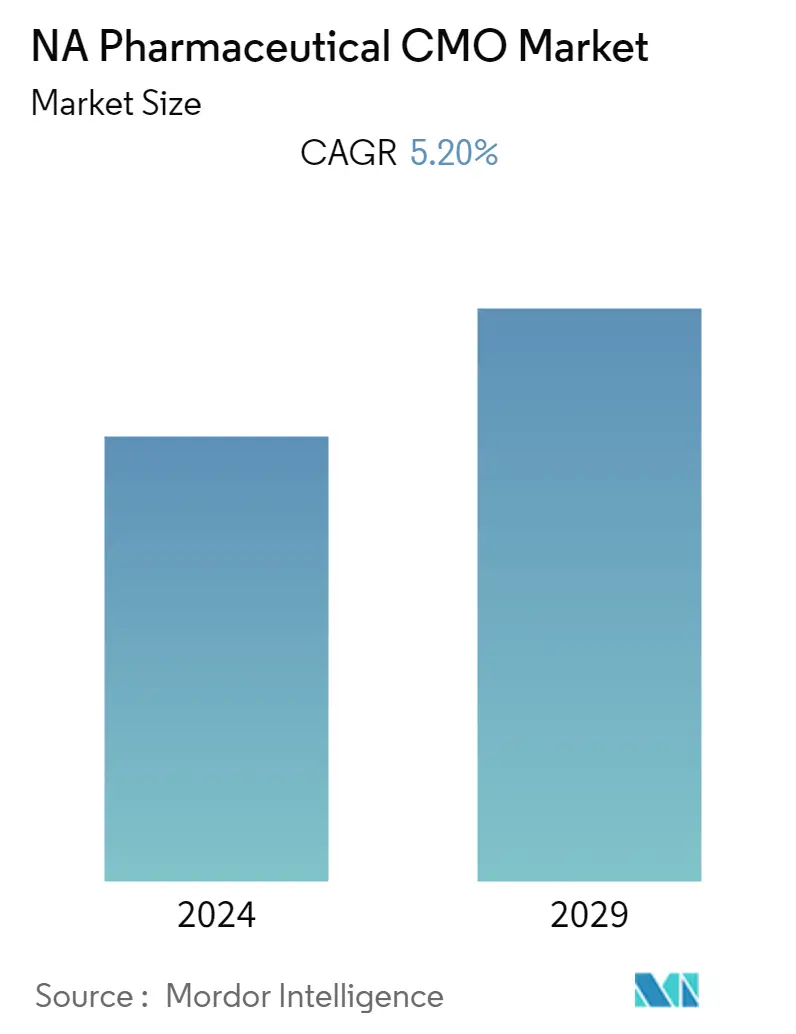
| Study Period | 2019 - 2029 |
| Base Year For Estimation | 2023 |
| Forecast Data Period | 2024 - 2029 |
| Historical Data Period | 2019 - 2022 |
| CAGR | 5.20 % |
| Market Concentration | Medium |
Major Players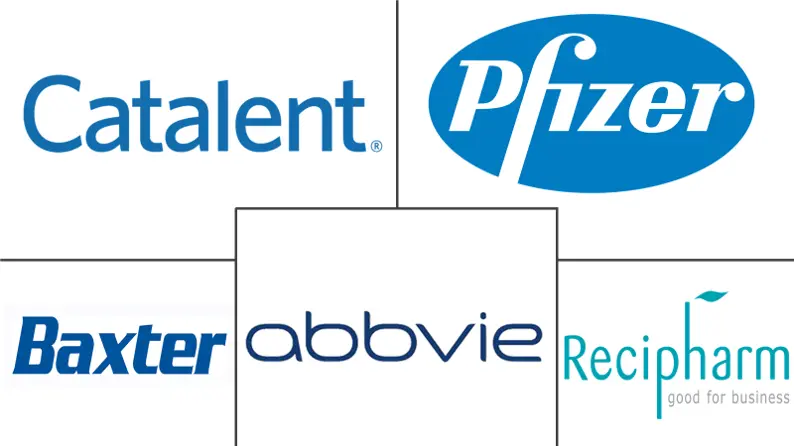
*Disclaimer: Major Players sorted in no particular order |
North America Pharmaceutical Contract Manufacturing Market Analysis
The North America Pharmaceutical Contract Manufacturing Market was valued at USD 45.13 billion is expected to reach USD 62.04 billion at a CAGR of 5.2% over the forecast period from 2021 - 2026. Generic drugs present a massive opportunity for growth for the CMOs of North America. Traditionally, the CMOs of this region were unwilling to take risks about generics that produce low margins. However, as growing prices push more companies to enter into dermatology products, CMOs with semisolid capabilities benefit from strong generics demand. These generic drug companies are also turning more toward CMOs with injectable skills to overcome the shortage and address issues relating to offshore supplies.
- The pharmaceutical industry is one of the most innovative sectors in Canada. Pharmaceutical, a vital segment of the Canadian economy, is supported by the Canadian government. It provides a business-friendly environment for pharmaceutical companies and can leverage assets for short- and long-term business strategies. In the wake of the patent cliff, pharmaceutical companies in this region are reorganizing and looking for new business models built on third-party partnerships and external networks. This business model mostly relies on outsourcing most of the operations, including manufacturing and providing excellent growth opportunities for CMOs in this region.
- As of 2019, there are more than 800 active Investigational New Drug (IND) waiting for approval with the FDA. These burgeoning approvals and drug-developing pipelines are expected to promise more opportunities to CMOs in the future. Nevertheless, many of the drugs approved had an orphan designation, which suggests that they are targeted for people with rare diseases. Even though high prices deliver larger margins, the volumes are too low for large CMOs looking for growth. Also, the increasing per-capita health expenditure is a reliable indicator of the growing pharmaceutical sector and the pharmaceutical CMO market.
- Canada also holds the advantage of having a skilled workforce. Although Canada is going to face intense competition from the emerging Asian countries, the complex manufacturing processes required for certain drugs, which need qualified personnel, stable political environment, and the proximity to the end market of the United States and Canada, are expected to drive the growth of the pharmaceutical CMO market in this region. With intensifying international competition, CSPs based in Canada will seek to differentiate themselves in quality and advantages of scale in their services to appeal to the demands of global leaders in pharmacy.
- The coronavirus outbreak in China significantly affected the supply of finished drugs and APIs to the US. An estimated 83% of Chinese import lines to the US were human finished dosage forms, while 7.5% were APIs in 2018. Factory lockdowns in China and logistics delays due to coronavirus measures at ports would mean lower production and delays in shipping of APIs to US manufacturers. With the coronavirus spreading in the EU, US pharmaceutical companies will have to brace for cost escalations. Many CMOs, along with pharmaceutical companies in the region, are contemplating the get approval for the clinical trial of vaccines to prevent the COVID-19 infection.
North America Pharmaceutical Contract Manufacturing Market Trends
This section covers the major market trends shaping the North America Pharmaceutical Contract Manufacturing Market according to our research experts:
Finished Dosage Formulation (FDF) Development and Manufacturing is Expected to Witness Significant Growth
- The International Society of Aesthetic Plastic Surgery reported that with 4,361,867 cases, the United States ranked first in the total number of cosmetic procedures, in 2018. As of 2019, of those surveyed by the American Society for Dermatologic Surgery (ASDS), 70% were somewhat to extremely bothered by the lines and wrinkles around the eyes and led them to cosmetic procedures. The ASDS also stated that the demand for cosmetic surgery products is expected to rise in the United States, with injectables as the most significant and fastest-growing segment in the market.
- The US FDA later approved the use of injectable dermal fillers based on the review of data collected from controlled clinical studies that evaluated the safe and effective use of wrinkle fillers when injected into particular areas of facial tissue. Additionally, botox injections have increased in the country over the years. Moreover, according to the American Academy of Cosmetic Dentistry's Cosmetic Dentistry State of the Industry Survey, there was an increase in the number of patients seeking cosmetic dentistry and a rise in the average production per cosmetic patient per visit. This has also driven the demand for facial dentistry in the country.
- Baxter also acquired Claris injectables Ltd and gained complete access to the Claris Injectables product portfolio. Meitheal Pharmaceuticals Inc., a generic injectables company, got the US FDA approval for Enoxaparin Sodium Injection, USP, the generic equivalent of Lovenox. The company licensed Enoxaparin Sodium Injection exclusively through its partnership with Nanjing King-friend Biochemical Pharmaceutical Co. Ltd. Additionally, according to ICRA Limited, injectables drugs worth USD 16 billion went off-patent in the United States alone. The United States is witnessing a rise in demand for generic injectables, on account of increasing investment by the US Government for the development of generic drugs.
- Furthermore, the increase in the number of chronic illnesses, like diabetes and cancer (with roughly 1.8 million people diagnosed with cancer in 2019 and 34 million diabetic people in the United States), has increased the requirement for injectable drug delivery. Moreover, in the United States, drug shortages are a prime concern for consumers and the FDA. Though the number of new drug shortages has declined since 2011 due to the work of the FDA, industry, and other stakeholders, there is still a shortage of medically necessary products. In 2018, 63.7% of all drugs in shortage were sterile injectables, reported the US FDA. Quality problems at manufacturing sites can cause supply disruptions.
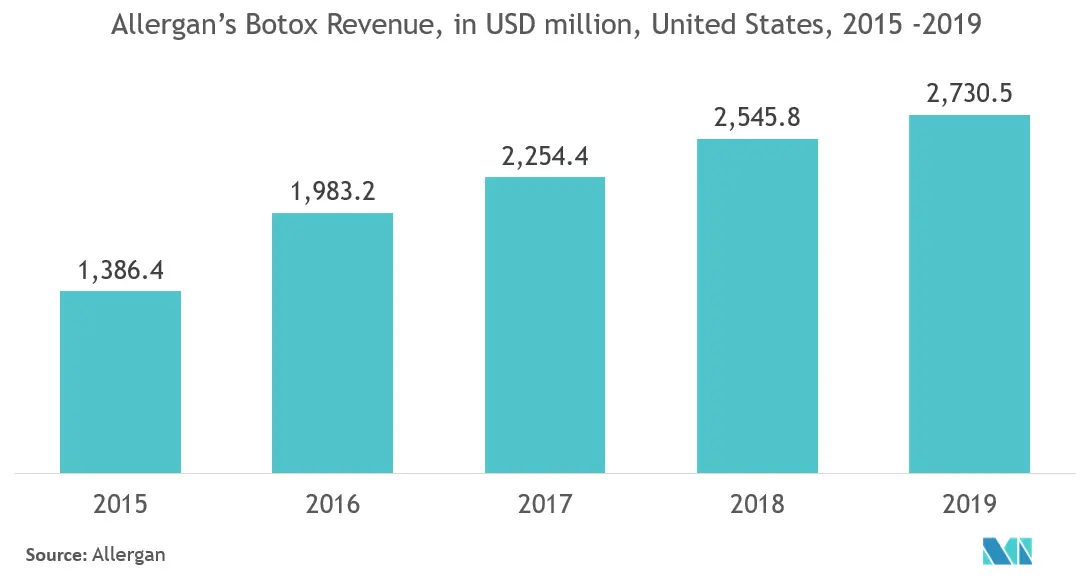
United States is Expected to Hold Major Share
- The United States has emerged as the largest market for drugs and accounts for almost half of the R&D spending in pharmaceutical and biotechnology markets. Hence, CMOs play a critical role in this market and have invested in new facilities and technologies to cater to a wide range of outsourcers. The country is experiencing a shortage of manufacturing capability for specific sectors, like cell and gene therapy. The CMOs have increased their manufacturing bases over the past two years. 2018 has been widely considered as a ‘breakthrough year’ for the United States in terms of approval of new molecular entities and biologics applications. In 2018, the Center for Drug Evaluation and Research approved a record 59 novel drugs in nearly two decades.
- The United States health spending is expected to have a 0.8% faster growth than the gross domestic product (GDP) per year over the 2018-27 period. The health share of GDP would rise from 17.9% in 2017 to 19.4% by 2027, as per estimates from the Centers for Medicare & Medicaid Services. The stricter regulation in the country ensures superior quality of the manufacturing and the end-product that is being adhered to by the CMOs. For instance, manufacturing autologous or allogeneic therapies is complex, and the manufacturing facilities are required to attain a GMP accreditation.
- In February 2020, Alchem Laboratories Corporation, a contract manufacturing organization based in Alachua, Florida, focused on custom synthesis, announced an expansion of its screening and clinical trial manufacturing capabilities. The development was made through construction of Building 3, a 12,000 square foot multi-use facility dedicated to high-throughput screening, biologic and drug product manufacturing clean-room areas, and analytical support. Pfizer, in mid-2019, announced an additional investment of USD 500 with the strategy is in line to increase manufacturing capability at its gene therapy plant, 230-acre campus in Sanford, North Carolina.
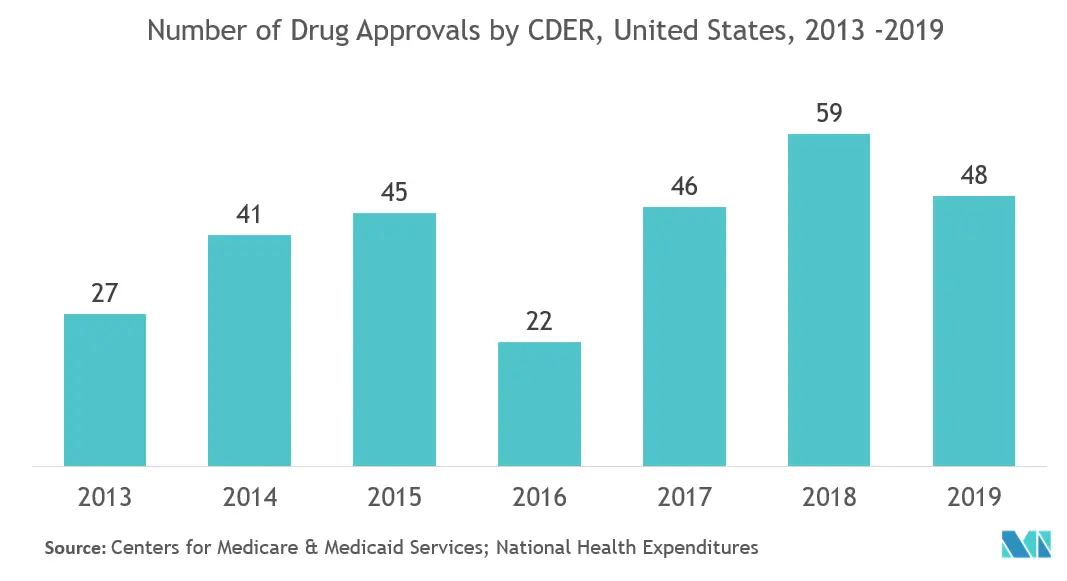
North America Pharmaceutical Contract Manufacturing Industry Overview
The North America Pharmaceutical Contract Manufacturing Market is highly competitive as there is a robust presence of pharma and biotech research activity in the region. The consolidation of CMOs is expected to occur within the next few years, as the competitors will either leave the industry, or abandon a specific area within the industry, or go out of business. This improves the pricing power of value-added CMOs.
- May 2020 - Arcturus Therapeutics Holdings Inc. and Catalent, Inc. announced a partnership to support the expected manufacture of Arcturus' COVID-19 mRNA vaccine candidate (LUNAR-COV19), intended to protect against the SARS-CoV-2 coronavirus. The production of LUNAR-COV19 at Catalent's state-of-the-art drug substance biomanufacturing facility in Madison, Wisconsin, will support human clinical studies and, if successful, commercialization of the vaccine.
- May 2020 - AbbVie announced that the U.S. Federal Trade Commission (FTC) had accepted the proposed consent order in connection with AbbVie's pending acquisition of Allergan. The acceptance by the FTC satisfies all required antitrust clearances needed to be obtained for the acquisition of Allergan by AbbVie.
North America Pharmaceutical Contract Manufacturing Market Leaders
-
Catalent Inc.
-
Pfizer CentreSource (Pfizer Inc.)
-
Baxter Biopharma Solutions (Baxter International Inc.)
-
Recipharm AB
-
AbbVie, Inc.
*Disclaimer: Major Players sorted in no particular order
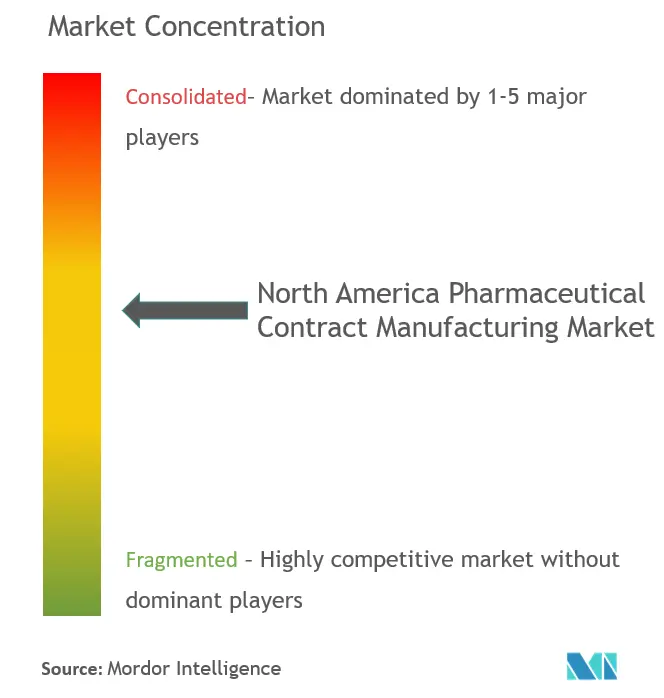
North America Pharmaceutical Contract Manufacturing Market Report - Table of Contents
1. INTRODUCTION
- 1.1 Study Assumptions and Market Definition
- 1.2 Scope of the Study
2. RESEARCH METHODOLOGY
3. EXECUTIVE SUMMARY
4. MARKET DYNAMICS
- 4.1 Market Overview
-
4.2 Industry Attractiveness - Porter's Five Forces Analysis
- 4.2.1 Bargaining Power of Suppliers
- 4.2.2 Bargaining Power of Consumers
- 4.2.3 Threat of New Entrants
- 4.2.4 Threat of Substitute Products
- 4.2.5 Intensity of Competitive Rivalry
- 4.3 Industry Value Chain Analysis
- 4.4 Industry Policies
-
4.5 Market Drivers
- 4.5.1 Growing emphasis on drug discovery and outsourcing of manufacturing
- 4.5.2 Strong R&D Investments
-
4.6 Market Challenges
- 4.6.1 Presence of Low-cost alternatives for outsourcing
- 4.6.2 Regulatory & Operational concerns due to the move towards serialization
- 4.7 Key considerations involved in the selection of a CMO in North America and the impact of the growing presence of low-cost alternatives in the APAC region
- 4.8 Impact of COVID-19 on CMOs and analysis on the short & medium-term impact on manufacturing output
5. TECHNOLOGY SNAPSHOT
6. MARKET SEGMENTATION
-
6.1 By Service Type
- 6.1.1 Active Pharmaceutical Ingredient (API) Manufacturing
- 6.1.1.1 Small Molecule
- 6.1.1.2 Large Molecule
- 6.1.1.3 High Potency API (HPAPI)
- 6.1.2 Finished Dosage Formulation (FDF) Development and Manufacturing
- 6.1.2.1 Solid Dose Formulation
- 6.1.2.2 Liquid Dose Formulation
- 6.1.2.3 Injectable Dose Formulation
- 6.1.3 Secondary Packaging
-
6.2 Country
- 6.2.1 United States
- 6.2.2 Canada
7. RELATIVE POSITIONING ANALYSIS
8. COMPETITIVE LANDSCAPE
-
8.1 Company Profiles
- 8.1.1 Catalent Inc.
- 8.1.2 Recipharm AB
- 8.1.3 Jubilant Life Sciences Ltd
- 8.1.4 Thermo Fisher Scientific Inc. (Patheon Inc.)
- 8.1.5 Boehringer Ingelheim Group
- 8.1.6 Pfizer CentreSource (Pfizer Inc.)
- 8.1.7 Aenova Group
- 8.1.8 AbbVie, Inc.
- 8.1.9 Baxter Biopharma Solutions (Baxter International Inc.)
- 8.1.10 Lonza Group AG
- 8.1.11 Siegfried AG
- *List Not Exhaustive
9. INVESTMENT ANALYSIS
10. FUTURE OF THE MARKET
** Subject To AvailablityNorth America Pharmaceutical Contract Manufacturing Industry Segmentation
A contract manufacturing organization (CMO) is an organization that serves the pharmaceutical industry and provides clients with comprehensive services, from drug development to production. Outsourcing to a CMO allows the pharmaceutical client to expand its technical resources without increased overhead. The client can then manage its internal resources and costs by focusing on core competencies and high-value projects while reducing or not adding infrastructure or technical staff. In the pharmaceutical sector, with ongoing growth, the pharmaceutical innovator companies need to stock their pipelines with new drugs. Still, they do not have the resources they once had to discover, develop, and manufacture products. Hence, the requirement for CMOs is quite significant.
| By Service Type | Active Pharmaceutical Ingredient (API) Manufacturing | Small Molecule |
| Large Molecule | ||
| High Potency API (HPAPI) | ||
| By Service Type | Finished Dosage Formulation (FDF) Development and Manufacturing | Solid Dose Formulation |
| Liquid Dose Formulation | ||
| Injectable Dose Formulation | ||
| By Service Type | Secondary Packaging | |
| Country | United States | |
| Canada |
North America Pharmaceutical Contract Manufacturing Market Research FAQs
What is the current NA Pharmaceutical CMO Market size?
The NA Pharmaceutical CMO Market is projected to register a CAGR of 5.20% during the forecast period (2024-2029)
Who are the key players in NA Pharmaceutical CMO Market?
Catalent Inc., Pfizer CentreSource (Pfizer Inc.) , Baxter Biopharma Solutions (Baxter International Inc.), Recipharm AB and AbbVie, Inc. are the major companies operating in the NA Pharmaceutical CMO Market.
What years does this NA Pharmaceutical CMO Market cover?
The report covers the NA Pharmaceutical CMO Market historical market size for years: 2019, 2020, 2021, 2022 and 2023. The report also forecasts the NA Pharmaceutical CMO Market size for years: 2024, 2025, 2026, 2027, 2028 and 2029.
NA Pharmaceutical CMO Industry Report
Statistics for the 2024 NA Pharmaceutical CMO market share, size and revenue growth rate, created by Mordor Intelligence™ Industry Reports. NA Pharmaceutical CMO analysis includes a market forecast outlook to 2029 and historical overview. Get a sample of this industry analysis as a free report PDF download.



